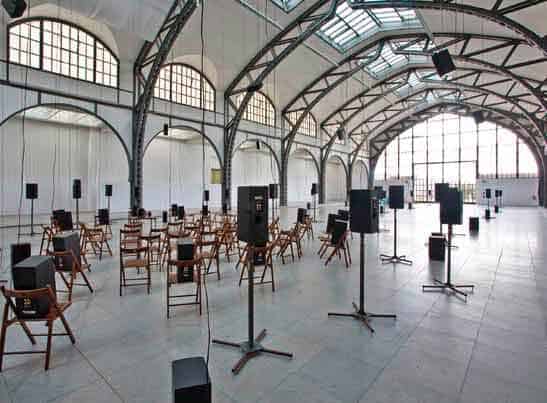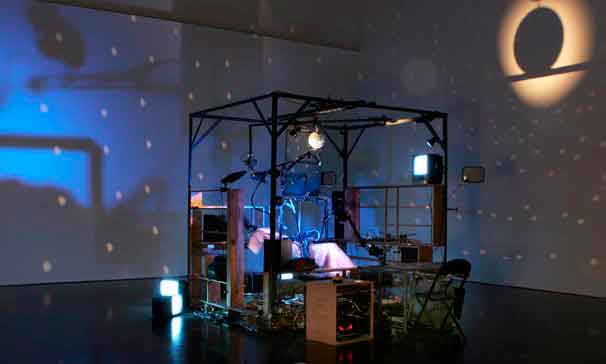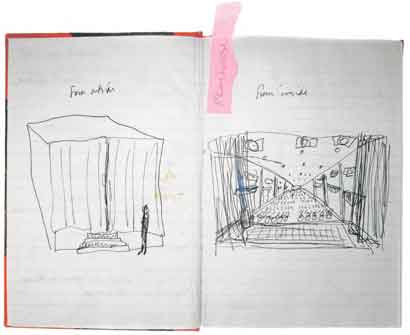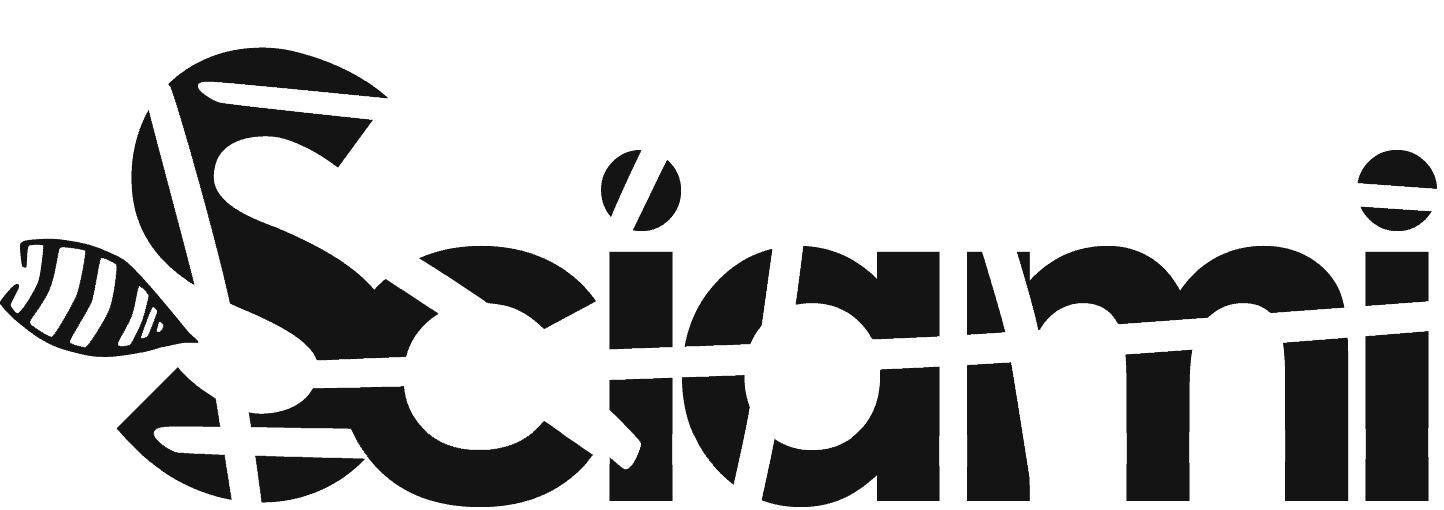Originally published in: Paul David Young, newARTtheatre. Evolutions of the Performance Aesthetic, PAJ Publications, New York 2014, pp. 61-71.
While invoking theatre explicitly, visual artists allow themselves the freedom to redefine the parameters of the medium. They create alternative forms of texts and devise open-ended narrative styles. The text in the visual arts context is decentered, one piece among many that contribute to the overall experience.
Likewise, in the use of space, visual artists readily disregard the architecture of theatre. They create immersive environments. Or they provide a mechanism to thrust the spectator into a new experience of the ready-made of the world around her. Though the power of the voice has been a staple of theatre from time immemorial, since the late 1990s the Canadian partners Janet Cardiff and George Bures Miller have pushed the exploration of the voice and text in the visual art environment, developing soundtracks that convert the experience of an installation or real-world place into theatre. The porousness and interactive qualities of their work seek to reconfigure the relationship of the spectator to the performance. The spectator is prodded into collaboration. Though their work travels extensively internationally, it manages to maintain its theatrical power to cause a specific experience of the place where it is exhibited. They have produced audio and video walks, in which a recorded voice delivered through headphones guides individuals through the experience of a museum or other environment. They have also created installations much like theatrical sets in which recorded sound and voice evoke a narrative. The generally fragmentary, allusive, and suggestive texts that one hears are designed to employ the mind of the listener to construct her own narrative.
As the Canadian representatives at the 49th Venice Biennale, Cardiff and Miller gained worldwide attention and won both La Biennale di Venezia Special Award and the Benesse Prize with Paradise Institute, an installed movie theatre with a crime scene soundtrack. They have since exhibited at major institutions and galleries in Europe, the United States, and around the world.

In 2008, the British Columbia- and Berlin-based artists created the sound installation The Murder of Crows.
Previously presented at the Hamburger Bahnhof in Berlin and other venues, it was installed in 2012 at the Park Avenue Armory, New York, at which time this interview took place by telephone. In the vast, dark Park Avenue Armory drill hall, Cardiff and Miller arranged ninety-eight speakers, each with its own soundtrack, a mixture of music and sound effects. The sound traveled around the array of speakers, acquiring a strange physicality. In the center of the enormous hall, Cardiff’s voice recounted her dreams from an old-fashioned speaker horn, which rested on a table. Stylistically, The Murder of Crows was reminiscent of Cardiff’s 2001 sound installation, The Forty Part Motet, which consisted of forty speakers disseminated in a space, each carrying the voice of an individual singer. It was included in the 2010 Lincoln Center White Light Festival and has been exhibited at MoMA PS1 and other venues around the world.
Young: Talk about your relationship to theatre, because there’s definitely a theatrical element to your work. I’m thinking of Playhouse.
Miller: In a way I felt The Murder of Crows was moving away from the theatrical. It is theatrical, but we’d just done a few pieces that were even more theatrical, say, The Killing Machine or Opera for a Small Room. We used computerized lighting to move as the sound moved. With Playhouse we were thinking of a more simplified piece.

Cardiff: But at the same time, I think what happens is that we have a certain relationship with the audience that turns them into being a spectator.

Miller: A theatrical spectator.
Cardiff: Which is very much like in the theatrical world. Even with the video walks. We just finished a video walk in Kassel: FOREST (for a thousand years…), in dOCUMENTA (13). It’s nighttime. It’s like theatre. You’re watching different actions happen in different places as you go through a different space. So I think we have a really strong dialogue with contemporary theatre and dance in a lot of what we do.
Miller: We’re frustrated with theatre. We’re trying to immerse the audience in some way that you can’t do in theatre. In theatre, there’s always a line between you and the stage. It’s hard for it to be an immersive medium, whereas with sound, when the viewers close their eyes, they can be in a different world than you can be in the theatre.
Young: The Murder of Crows seems to take a different relationship to the audience than the audio walks, for example, which are more directed, in terms of how they speak to the audience member or spectator, kind of controlling or directing the choices that are made.
Cardiff: Yes, and I think it takes a different relationship than, say, takes place in The Forty Part Motet, which is a piece in a similar vein. The audience is not necessarily directed to sit down, but the whole concept of the piece is that when they move around it’s a different piece of music for everyone, whereas with The Murder of Crows we were more interested in the sound moving around the audience. They stay mainly in the sweet spot, we call it, and then we have the sound moving from one end of the space to the other end of the space.
Miller: And in that way it’s very different from the walks, because the viewer is moving and the sound is always with them in their headphones, but here we wanted them almost in a sound booth, a sound environment.
Cardiff: We just like working in a lot of different ways too. With the walks, we love to have the physical reality and the virtual reality lined up. There is this strange interaction that happens.
Miller: Quite often synchronistic events happen in that situation with the walks. They are a very different form of work. We’re always trying to do something new and change. We’ve wanted to do something similar to The Forty Part Motet where you just use speakers, and it’s a fairly simple setup, just using the sounds to move people around. That was a problem we set ourselves.
Young: In The Murder of Crows at the Armory, I found it disturbing that there were chairs in the environment, because my instinct was to walk around.
Miller: If you’re asking the audience to stay for thirty minutes in the same spot, we’re not against providing some comfort for them.
Cardiff: Back to your question about theatre, I saw it as a bit of a set. Years ago we saw a piece in Berlin, a reworking of Beckett’s play Krapp’s Last Tape, and in ways there are many of our pieces that reference that work, where there is a single performer on stage recalling something. So for me it’s a piece where the audience can sit there and there’s a symphony around them. In theatre, the symphony is in the pit, whereas with this one the symphony is around them, so it definitely does reference traditional theatrical setups. Like Opera for a Small Room.
Miller: Which is very theatrically based. It’s a set basically in the middle of the gallery space, a room filled with records and record players, and you hear a voice coming out of a megaphone and the lights move and the sounds move.
Young: I had seen a similar piece at a group show at Luhring Augustine Gallery in Chelsea, where there were telephones. It was called Dreams—Telephone Series.
Cardiff: You’re right. They came from the same place. Those dreams that we used for the telephones were recorded in Kathmandu at the same time we recorded the other dreams. We didn’t realize we were going to use the dreams for The Murder of Crows until later, but they come from that period.
Miller: We were recording our dreams at night, so those dreams from the piece are actually recorded at the bedside, which gives it that feeling of….
Cardiff: Somnambulism.
Miller: So if there’s a sleepwalking tone to her voice, it’s because she basically is sleeping.
Young: That is what I inferred; otherwise, you’re a great actress.
Cardiff: No, I’m not a great actress.
Young: In taking up that practice, were you deliberately referring to Freudian theory? Freud counseled his patients to write down their dreams immediately upon waking so as to have their freshest impressions.
Cardiff: Well, with the telephone series we were definitely referencing Freud because the telephone was from a similar era.
Miller: From the thirties anyway.
Cardiff: Yes, you know, one of those telephones sitting on Freud’s desk. So I think you definitely picked up on that reference. I can’t remember at what point we were researching dreams, and of course that Goya image [The Sleep of Reason Produces Monsters] came up and some other stuff, and reading about Freud and the recording of dreams – that all came into it, but nothing is very direct. Although the horn is a direct reference to the etching: we see him lying on the table and all the crazy monsters are behind him and you can’t wake him up.
Young: The brochure for The Murder of Crows at the Park Avenue Armory says, “The piece is a requiem to a world of positivity and utopia that-although heralded at the end of the cold war after 1989 – seems to have disappeared in our time of pathological ‘war on terror’ and ‘ethnocidal’ violence that mark the darker side of globalization.”
Miller: We were making this piece in the dark days of the Iraq War. It was the most depressing time.
Cardiff: We started the piece in 2006.
Miller: Or earlier than that. We just respond to what’s going on in the world, so it has a dark tone to it. When we were making it we were thinking of it as a reaction to that time. I have said it was a requiem for the previous age. After 9/11 everything changed so radically in a way, and maybe it really didn’t, but it did in the mind or in the media.
Cardiff: I think it refers to the war in Iraq because when we started the piece we were getting the Herald Tribune pretty regularly and there were always these horrific articles about what was going on, and for the international version, more than the domestic version, there’d be more from the Iraqi side of things. One of the articles that was particularly inspiring was about a father who came home one day to find that his house had been blown up and his three daughters had been killed, and one of their arms was just hanging from the chandelier. The idea that there are people stuck in a situation and they can’t change it. An ordinary person has their family killed and has no ability to do anything about it. They’re powerless. So it’s a lot about the Goya series, and I think we were in a situation in Kathmandu where I was having nightmares and the helpless feelings of being in the dream.
Miller: You couldn’t tie it to the piece directly. It moves subconsciously like a dream in a way, and that’s what we wanted the piece to have.
Cardiff: One reviewer talked about the horn as a reference to 1984, the George Orwell novel. I actually reread that novel when we were producing the piece, and I kept saying that this is just like the media now. Who is the U.S. at war with now? Which power are we at war with now? It’s very 1984.
Young: The other thing that I noticed about this piece, and it did remind me of The Forty Part Motet, is the prevalence of music.
Cardiff: We were reading books about the emotional impact of music, how music connects to you on a subconscious level. One of the problems we set ourselves was this idea of how you can move people without visuals. How do you move people? How do you make a film soundtrack? And of course music is a big part of that. So we collaborated with a composer in Berlin, and we also used a composition by a Montreal composer, Freida Abtan, for an electronic section. And then we worked with the composer Tilman Ritter for the operatic section. We gave him the words for the libretto and a lot of suggestions.
Miller: He’s a film composer so he’s used to working collaboratively.
Cardiff: We always wanted to do a big guitar sequence, so we invited a lot of guitarists to our studio out west and we started working like that. Mainly, in the way the Motet separates the singers, we wanted to take apart an orchestra and take apart different instruments and have them move through the space but also just have some of them located in different parts of the space. That’s why we also use the Russian choir coming in. Of course it also has its subtext.
Young: Do you consider yourself to be a writer?
Cardiff: No. That’s a short answer isn’t it?.
Young: There is a lot of text in your pieces.
Cardiff: I think at one point I was interested in writing a novel. About fifteen years ago I started, but I realized that I’m not a very good writer at all. The types of writers that I admire, I could never be. But I think the form we end up working in requires some writing. It’s a kind of three-dimensional writing, triggering people’s ideas and memories rather than creating full scenes. We’re able to complement the writing with sound effects and, in the case of the video walks, with visuals.
Miller: In The Murder of Crows we set out with no vocal narrative and then—we’d been building all these seeds with the music and sound effects—we felt that we weren’t getting enough from all that, that we needed to add something else.
Cardiff: Some structure.
Miller: To give people a more coherent image in their minds. We’d recorded the dreams, and these dreams we chose fit very nicely with the music and sound effects that we’d already been working on. They gave it this kind of structure and filled it in. The sound effects and the music weren’t doing what we wanted the piece to do. It needed something else. It’s interesting because the Kassel piece, FOREST (for a thousand years…), has no vocal narrative.
Cardiff: But it also has the beautiful forest to sit in, so it has the visuals. It could be a film basically. There’s a bomb sequence, and we even have a monster scene in it. Usually we like to have a funny part, but I’d say Murder isn’t so comical.
Miller: But there’s the aria part. The music for that is almost like Queen. We were trying to reference Wayne’s World where they’re singing Bohemian Rhapsody in the car. Well, no I’m not going to go off on that track.
Young: Thank you so much for your time. I know you are traveling.
Cardiff: We’re in Ontario, visiting my parents. Young: I’m in San Francisco myself.
Cardiff: I remember someone told me that our audio walk is up at the San Francisco Museum of Modern Art. It’s called Time Telephone.
Young: Is it part of the show on theatricality in art, Stage Presence?
Miller: Yes.
Young: I’m going to see that this afternoon.
Cardiff: Then don’t miss our audio walk there. They’re changing the building so much that it might be the last time to see it. We are hoping that they can reconfigure it, but we don’t know yet.
